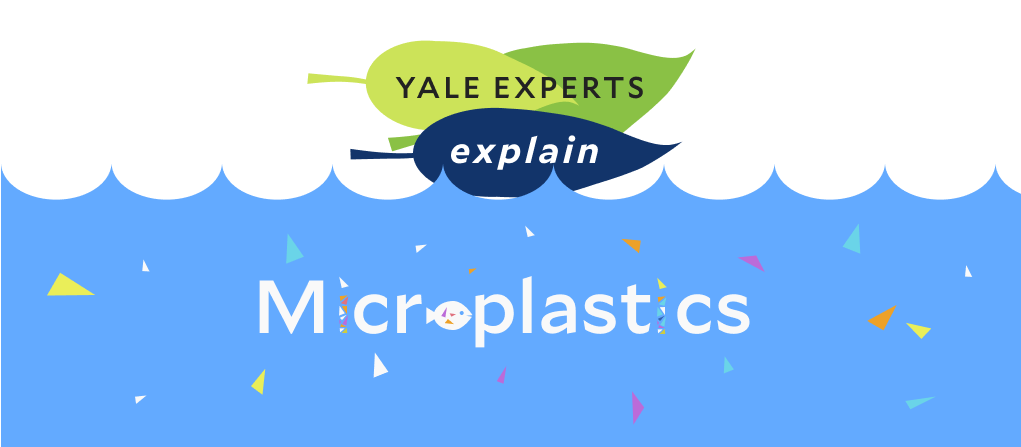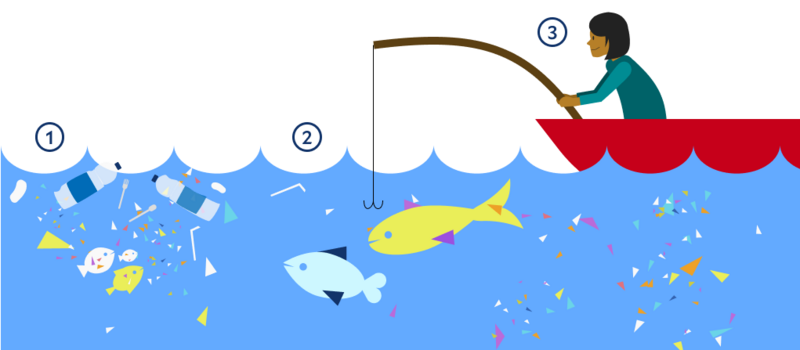
Environmental health expert Leigh Shemitz and green chemist Paul Anastas walk us through a tiny problem with big environmental consequences.
What are microplastics, and where do they come from?
“As their name suggests, microplastics are tiny plastic particles less than five millimeters in size,” says Dr. Leigh Shemitz (MFS ‘92, PhD. ’04), President of SoundWaters. “These pieces range anywhere from about the diameter of a grain of rice to where they need to be seen under a microscope.”
There are a wide range of sources of microplastics, including landfills, residential households and personal items, construction projects, factories, agriculture, and more. “In the last not even one hundred years–mostly since the 1950s–we as humans have produced 8 billion tons of plastic, and the estimate is only about ten percent of that has been recycled,” Shemitz says. “So where do microplastics come from? It comes from all of our stuff.”
Paul Anastas, the Director of the Center for Green Chemistry and Green Engineering and the Teresa and H. John Heinz III Professor in the Practice of Chemistry for the Environment at Yale University, explains that there are both primary and secondary microplastics. “Primary microplastics are plastic particles designed to be very small for them to carry out their intended function.” Anastas says, adding that these plastic microbeads are often found as small spheres in exfoliating face washes or as fine powder in toothpaste and sunscreen. “Typically, they are washed down the drain, slip through water treatment plants, and enter into waterways.”
On the other hand, secondary microplastics are “large plastic materials that could be used in packaging or building materials that just get ground down over time either through abrasion, wind, or sun rays, and become microplastics,” Anastas explains. Plastics bags, bottles, and food containers, as well as paints, adhesives and coatings, and electronics are all examples of materials that can break down and release secondary microplastics. Washing clothing made with synthetic fibers in washing machines is another common way that households often unknowingly contribute to the microplastics problem.
Where are microplastics found?
“They’re being found almost everywhere we’re looking,” Anastas says. Both primary and secondary microplastics are being found in oceans, lakes, waterways, soil, air, and unfortunately, even our food.
“There is a lot of research now suggesting just how ubiquitous they are,” Shemitz adds. “There is no part of the globe that does not have microplastics, from the Arctic, to the Antarctic, and everything in between.” However, Anastas explains that there is “dramatically less knowledge about microplastics in the air and in the soil in comparison to microplastics in water.” This is because microplastics in water are easy to find, test, and analyze – and it is simply where the attention of researchers is focused on for now.

What are the environmental impacts of microplastics?
Microplastics have significant environmental impacts, most studied in marine environments. Once released or broken away from their original plastic product, microplastics can travel through waterways and end up in the ecosystems that serve as homes to a range of marine life, including algae, zooplankton, fish, crabs, sea turtles, and birds. Shemitz points out that there are many cases of entanglement, where marine life becomes trapped in pieces of plastic like old fishing line and are strangled to death. “Microplastics are also a concern particularly in the ocean because they are so easily ingested by living things,” Anastas says. “When a fish or invertebrate absorbs these microplastics by eating them, they can experience health problems such as a severe interference to or an abrasion with their digestive tracts, which can be fatal.”
Further, other pollutants from the water tend to collect on the surface of these microplastics; when animals ingest the plastic, they are also ingesting those toxic chemicals. These substances begin to accumulate in their body and slowly make their way up the food chain.
Does exposure to microplastics have human health impacts?
Ecologists have found that microplastics often make their way into drinking water as well as foods like salt, honey, and sugar; some research suggests that humans are consuming more than 100,000 microplastics particles a year. However, there are many unanswered questions about the impacts of microplastics on humans and how the human body responds to the microplastics that we eat, drink, or inhale.
Anastas points out that we do know that inhaling very fine particles of any type of materials can also cause respiratory irritation that could lead to more serious cardiovascular problems, but some of the long-term, hidden health concerns are not yet known. “Plastics are made simply by connecting small chemicals together in chains until they become big chemicals that can be used as materials, and these are called polymers,” Anastas explains. “In addition to most man-made materials, polymers are the foundation of many things in nature. Every tree is a polymer. Your skin is a polymer. Every food you eat is a polymer.”
Anastas goes on to explain that our bodies are accustomed to breaking down, processing, and disposing of natural polymers every day, but newer man-made polymers come with many unknowns. “We just don’t know to what degree these human-made polymers are different and affect our bodies differently,” Anastas explains. “Our bodies evolved to process all of these other natural polymers over countless years, but our bodies and the environment have not been given the chance to evolve to process these man-made polymers.”

For the time being, researchers use the data that exists on microplastics to make educated guesses on what might also be happening in the human body. “What we have seen in marine environments is how microplastics can disrupt reproductive systems, stunt growth, diminish appetite, and cause tissue inflammation and liver damage,” Shemitz points out. “So as those studies suggest, there is no ‘no effect’ right now. It is likely that ingesting microplastics, as we all do, could expose us further to some of the chemicals that are found in plastics that are known to be harmful.”
What efforts are being taken by industry and governments to solve this problem?
There is increasing pressure on governments and industries to prevent microplastics from entering the environment, and Shemitz explains that industries are beginning to reassess their contribution to the problem. She says that some companies have started up initiatives to make products or packaging out of recycled plastic to “reduce the overall tonnage of plastic that is produced every year.”
In the public sector, Shemitz is encouraged by the local, state, and federal legislation around banning microbeads in personal care products. Some states and municipalities – like Connecticut – have even started plastic bag bans, and Shemitz has witnessed first-hand the dramatic reduction in plastic bag pollution in her hometown of Stamford.
In addition to only adjusting the usage and availability of single-use plastic, Anastas suggests that “the solution is to design our plastics to have the character, the quality, and the nature that is healthful and sustainable, not just simply bad.” “Plastics aren’t bad, bad plastics are bad,” Anastas says. “Bad plastics start off being made from toxic, depleting, finite materials, like oil and petroleum, and do not degrade for tens of thousands of years. Industries are beginning to reinvent plastics so they can actually be good, and that means starting with renewable material like plant matter that can degrade harmlessly into our environment.”
How can consumers reduce microplastics in the environment?
When consumers manage their personal exposure to microplastics, they also keep microplastics from entering the environment. Our experts suggest avoiding single-use plastics by, for example, opting for reusable glass bottles and containers and against products with microbeads, like exfoliating cosmetics. In addition to small changes in habits, Anastas suggests “getting to know what you can demand as a consumer.”
“Right now, there are greener plastics being introduced but people aren’t familiar with them yet,” Anastas says. “A lot of these new plant-based, biodegradable products are similar to the natural polymers you would find in trees, leaves, and grass. You need to know they exist and demand them in your products.” Anastas is optimistic that a consumer push towards greener products will force industry to use the technical expertise that they already have to come up with positive solutions.

“There is nothing magical about designing things,” Anastas says. “Maybe one hundred years ago, we had ignorance to hide behind, but we don’t have that ignorance anymore. We actually know how to design things so that they’re not going to be harmful to our bodies and to the biosphere … We can do this.”
Beyond adjusting your individual consumption habits to reduce future microplastics, Shemitz recommends raising your own awareness to the problem by getting involved in local clean up efforts to reduce the plastics already polluting the environment. Facing the problem first hand, Shemitz believes, is the only way. “Making the problem visible to people is really an important part of understanding plastics in the environment,” Shemitz says. “We have to own all of it, not just what we buy and use, but everything we see. We got all of the plastic out there, and together we can get a lot of that plastic out.”
What is Yale doing?
Yale eliminated 11,000 single-use water bottles from the 2019 Commencement weekend, instead encouraging honorees and guests to bring their own reusable bottles or use compostable cups at hydration stations in and around Old Campus. In previous years, Yale distributed more than 300 cases of individual plastic water bottles, many of which were left unopened after the ceremonies had concluded. Waste reduction efforts at Commencement will continue to expand in the future.
As COVID-19 emerged, To-Go dining and single-use containers became a necessary public health precaution on campus. In the face of this challenge, Yale Sustainability convened operational partners across campus to design and implement a four-stream materials management system in outdoor spaces to guide students in properly sorting their single-use waste. Further, Yale Sustainability has partnered with student groups to lead fun, engaging campaigns to encourage the safe use of reusable bags when retrieving takeout.